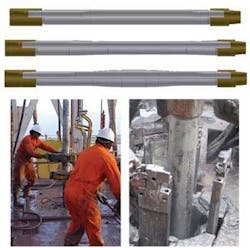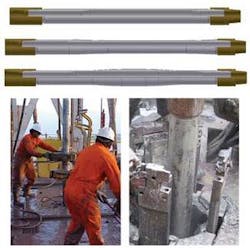Aluminum may be key to long, deepwater wells
Mikhail Gelfgat, Vladimir Basovich - Aquatic Co.
Alex Adelman, Drilling Research and Development Corp.
Aluminum drill pipe (ADP) can extend the capacity for deeper and longer wells when using a standard rig. Aluminum pipe has low specific weight with high strength, and is corrosion resistant in H2S and CO2 environments.
For most applications, strength must be as high as possible to withstand the pipe’s own weight plus operational loads. Any reduction of the structure weight could benefit the overall design of a well, well cluster, or platform.
One of the most widely used light-weight construction materials, aluminum alloy (AA), is well known in aerospace, automotive, marine, and civil construction industries. Use of AA in the petroleum industry has been rare.
ADP world record
One exception is using AA in drill pipe. Frequent use of ADP in the former Soviet Union (FSU) showed reduced loads on hoisting equipment, reduced trip time, lower hydraulic losses, reduced mud pump loads, and lower transportation costs. ADP, together with movable 80- to 125-ton (72 to 113-metric-ton) capacity rigs, turbodrills, and cluster directional drilling, were used to conquer west Siberian swamps and taiga oil in the 1970s. A similar approach was used on ultra-deep wells with rigs of 300- to 400-ton (272-363 metric tons) capacity in the 1980s. The world record total measured depth (TMD) well was at Kola SG-3 reaching 12,242 m (40,202 ft) using aluminum drillstring.
Western drillers went for deeper and longer wells by developing high strength steel, high torque connections, and heavy rigs and platforms. Now, it is time to combine both approaches to extend current limits in water depth, well TMD, and casing set-up depth.
AA tubulars currently used for wells include various types of drill pipe, bottomhole assembly (BHA) parts, non-magnetic drill collars, housings for MWD systems, tubing, and drilling risers. AA tubular goods under development include production and completion risers, landing string, and casing.
Steel tool joint ADP
Design and specifications for aluminum drill pipe with steel tool joints were determined by ISO 15546 in 2002 (second edition expected in 2007).
The current design of ADP incorporates “hot assembling technology” for the steel tool joint aluminum pipe body connection. This shrink-fit system proved reliable in producing light alloy improved dependability drill pipe (LAIDP) with excellent fatigue strength properties. The system reduced aluminum pipe featuring external or internal upset ends to accommodate thread for tool joint connection and handling requirements. Pipe body wall thickness is varied for the same connection type. For example, LAIDP 147 mm (5.8 in.) OD with internal upsets can be delivered with 9, 11, 13, and 15 mm wall thickness. LAIDP could be made with protector thickening in the middle of the pipe to prevent pipe body wear during drillstring rotation. This protector also centers the pipe in a borehole to increase critical buckling load.
Heavy-wall LAIDP (HWLAIDP) differs only in that the aluminum body wall thickness usually is equal to the upset thickness. HWLAIDP usually is used as a stiffness transition from the BHA to the regular LAIDP at the bottom, and from LAIDP to steel pipe at the top of the drillstring.
Integral joint aluminum tubes
The ability to extrude aluminum tubes with upset ends permits cutting threads directly in the extruded product. This allows design of integral joint aluminum drillpipe for different functions, as well as tubing, casing, line pipes without couplings, and production or completion risers.
The typical integral joint tubing design challenge in production is providing high tolerance, straightness, alignment of the main body, and upset ends.
To reduce BHA weight, and to lower drag while drilling horizontal wells, special alloy non-magnetic drill collars (monel), used along with MWD systems, could be replaced by thick-wall integral ADP with high magnetic permeability.
Riser and other components
The aluminum drilling riser (ADR) concept follows the standard drilling riser design. The main thick-wall tube is about 56 cm (22 in.) OD with welded connections at each end, usually flanges. The kill and choke, booster, and hydraulic lines surround the main tube with connections in the flanges and are supported by the clamps.
Development and manufacture of the first aluminum alloy drilling riser for a floating platform indicated that aluminum is a promising light-weight material for a range of offshore applications. The weight reduction of TLP or spar risers can drastically change the design of such platforms. Moreover, platform weight requirements could be reduced by using aluminum alloys to manufacture other system components such as air cans and pressure vessels. A comprehensive approach to using more aluminum components on the platform can also contribute to improving corrosion protection.
The encouraging results of aluminum alloy drilling riser development motivate the search for uses of aluminum in the development of the ultra deepwater risers, including both drilling risers for water depths to 4,000 m (12,123 ft) and TLP, spar, and FPSO production risers. Opportunities in meeting these goals include:
- Using aluminum alloys to improve ductility and corrosion resistance, in addition to high strength
- Allowing more effective welding techniques
- Creating a riser joint connection with improved strength and reliability.
LAIDP production and operation
During the last few years, the total production of LAIDP exceeded 250,000 m (820,208 ft), including almost 10,000 m (32,808 ft) manufactured to drill deepwater geotechnical and horizontal wells.
Most of the LAIDP is 12 m (40 ft) long, 147 x 11 mm (5.75 x 0.43 in.) with 5 1/2-in. FH connection. It is used mostly to drill directional and horizontal wells in west Siberia. The average well TMD is 3,200-3,500 m (10,499-11,483 ft) with 500-600 m (1,640-1,968 ft) horizontal section. Some wells have up to 1,200 m (3,937 ft) horizontal sections and a TD of 4,300 m (14,000 ft). LAIDP is the only technology to reach such targets with 125-ton (113-metric-ton) capacity drilling rigs.
The mean life of one set of LAIDP is about 70,000 m (229,658 ft) using combined drilling method (downhole motor plus rotary) with 400 tool joint make-ups. Some pipe sets performed up to 90,000 m (295,275 ft) with 550 tool joint make-ups. This performance is superior to that of steel pipe in similar applications.
The first offshore field tests of special internal flush LAIDP 164 x 9 mm (6.5 x 0.35 in.) were carried out in 1991 from theBavenit geotechnical vessel in the Atlantic Ocean. This was riserless drilling with wireline coring and sampling. Several boreholes were drilled in the Josefin, Amper, and Gorrindge underwater mountains at a maximum water depth of 212 m (696 ft) and a borehole depth of 50 m (164 ft) with ADP showing excellent performance. Beginning in 1993, similar ADP were used by Fugro Engineers B.V. to drill from dynamically positioned geotechnical vessels Bucentaur and Bavenit, with displacement of 4,470 tons (4,055 metric tons), and Norskald. Drilling was in the Atlantic Ocean, Norwegian Sea, Gulf of Mexico, Strait of Gibraltar, offshore Japan, and Black Sea. No signs of pipe corrosion have been found after 10 years of operation. Drillstring length reached 1,981.5 m (6,500 ft) with drilling rig load capacity of up to 40 tons (36 metric tons). Altogether, more then 140 boreholes were completed. The LAIDP was the only way to arrange geotechnical studies and exploratory drilling at extreme water depth using available drilling platforms without incurring major costs. This type of operation was continued with internal flash LAIDP 131 x 13 mm (5.2 x 0.51 in.) in 2004.
LAIDP prospects
Torque and diagram are the problems when using steel pipe in extended reach drilling. It challenges designers to decrease specific weight of each single joint. The most radical approach is to use AA drill pipe. Analysis of LAIDP application in extra-long wells with more then 15 km (9.3 mi) displacement has been positive. Actually, AA drill pipe would be the only solution for wells of such length. Calculations were performed for the drillstring to manage a 17-km (10.6-mi) well on the Gullfaks field. In the same conditions, the steel drillstring could manage 12.2 km (7.6 mi). R&D and field tests would be necessary before this could be accomplished. Experience with managing 12.2-km (7.6-mi) drillstring at the Kola super deep well shows the possible success of such an enterprise.
Aluminum tubular advantages
Physical and mechanical properties:
- Low specific weight combined with high strength at a superior strength-to-weight ratio;
- Corrosion resistance to H2S and CO2
- Better hydraulics and dynamics
- Non-magnet
Operational specifics for aluminum drill pipes:
- Shorter tripping time
- Less energy consumption for string tripping and rotating
- Lower transportation costs
Manufacturing
- Direct extrusion provides superior consistent properties and shape variability
High scrap sale value
The main areas of ADP application
- Deeper and/or longer well using available “standard” rig - low cost solution to extend contractor’s capabilities
- Drilling in remote areas - cost-efficient helicopter transportation
- Ultra-deep wells, vertical with moderate offset, TMD of 30-50,000 ft
- Extended-reach wells

